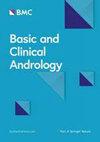男性阴道前庭旁隐窝炎的病因、临床表现和治疗方法
IF 2
3区 医学
Q2 ANDROLOGY
引用次数: 0
摘要
男性阴道前庭旁隐窝内可能会发生炎症性疾病。本研究旨在了解男性阴道前庭旁隐窝炎的病因、临床表现和治疗方法。13 名接受过阴道前庭旁隐窝炎治疗的患者为观察组,40 名健康人为对照组。患者的临床表现是隐窝中嵌有淡黄色油状物质。擦掉该物质后,可发现一个锥形盲腔样结构,开口直径为 1 至 5 毫米(2.8 ± 1.3 毫米),深度为 1 至 4 毫米(2.5 ± 1.1 毫米)。对照组未在隐窝中发现盲腔样结构。观察组和对照组双侧隐窝开口边缘之间的最短距离分别为 6 至 14 毫米(10.3 ± 2.4 毫米)和 2 至 10 毫米(3.9 ± 1.9 毫米),差异有统计学意义。皮损分泌物中的病原体检查显示,最常见的三种病原体是白色念珠菌、金黄色葡萄球菌和大肠杆菌。所有患者在接受抗生素治疗后都痊愈了。隐窝中的盲腔样结构可能与阴茎前蹼过宽有关。隐窝炎可能是由滞留在盲腔样结构中的污垢引起的继发性感染。保持肛门窦区域的清洁有助于预防隐窝炎的发生。抗生素治疗是有效的。本文章由计算机程序翻译,如有差异,请以英文原文为准。
Etiology, clinical manifestations, and management methods of cryptitis beside the preputial frenulum in men
Inflammatory diseases may occur within the crypt beside the preputial frenulum in men. This study was performed to gain an understanding of the etiology, clinical manifestations, and management methods of cryptitis beside the preputial frenulum in men. Thirteen patients treated for cryptitis beside the preputial frenulum served as the observation group, and 40 healthy individuals served as the control group. The patients’ clinical manifestation was the presence of a yellowish oily substance embedded in the crypt. Wiping off the substance revealed a conical blind cavity-like structure with an opening diameter of 1 to 5 mm (2.8 ± 1.3 mm) and depth of 1 to 4 mm (2.5 ± 1.1 mm). No blind cavity-like structures in the crypt were found in the control group. The shortest distance between the opening edges of the bilateral crypts in the observation and control groups was 6 to 14 mm (10.3 ± 2.4 mm) and 2 to 10 mm (3.9 ± 1.9 mm), respectively, with a statistically significant difference. Examination for pathogens in the secretions from skin lesions showed that the three most common pathogens were Candida albicans, Staphylococcus aureus, and Escherichia coli. All patients recovered after antibiotic treatment. A blind cavity-like structure in the crypt may be related to excessive width of the preputial frenulum. Cryptitis may be a secondary infection caused by smegma trapped in the blind cavity-like structure. Maintaining cleanliness in the frenulum area may help to prevent the occurrence of cryptitis. Antibiotic treatment is effective.
求助全文
通过发布文献求助,成功后即可免费获取论文全文。
去求助
来源期刊

Basic and Clinical Andrology
Medicine-Urology
CiteScore
3.50
自引率
0.00%
发文量
21
审稿时长
22 weeks
期刊介绍:
Basic and Clinical Andrology is an open access journal in the domain of andrology covering all aspects of male reproductive and sexual health in both human and animal models. The journal aims to bring to light the various clinical advancements and research developments in andrology from the international community.
 求助内容:
求助内容: 应助结果提醒方式:
应助结果提醒方式:


